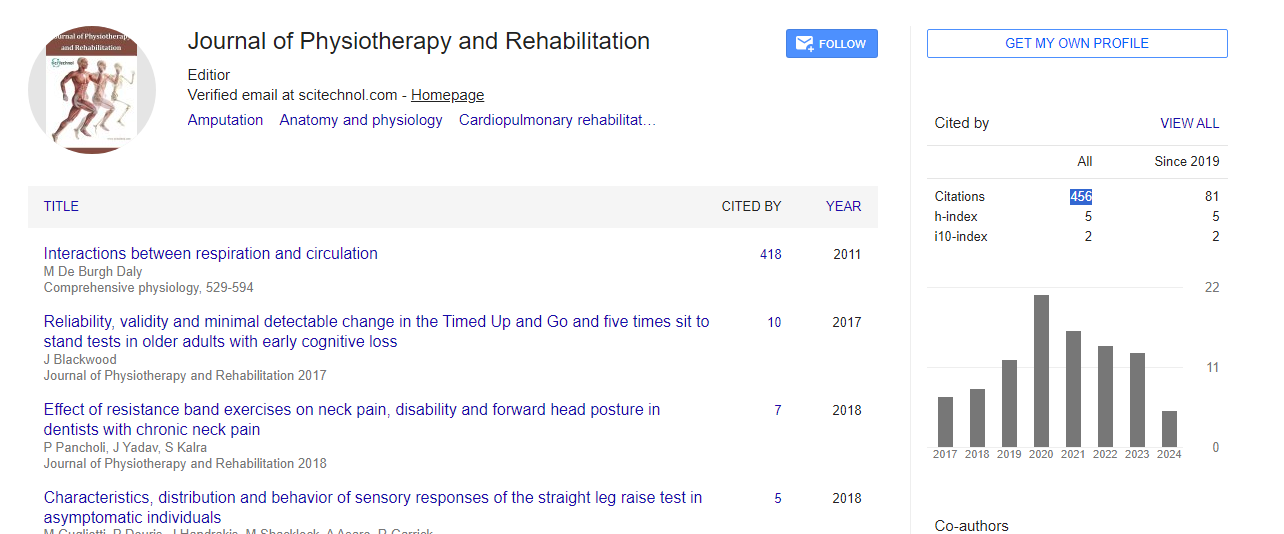Opinion Article, J Physiother Rehabi Vol: 8 Issue: 6
Importance of Anatomy and Physiology in the Effective Management of Chronic Pain and Injury Rehabilitation
Lingxiao Shimizu*
1Department of Anatomy, Harbin Medical University, Harbin, China
*Corresponding Author: Lingxiao Shimizu,
Department of Anatomy, Harbin
Medical University, Harbin, China
E-mail: shimizuling@edu.cn
Received date: 23 November, 2024, Manuscript No. JPTR-24-155485;
Editor assigned date: 25 November, 2024, PreQC No. JPTR-24-155485 (PQ);
Reviewed date: 09 December, 2024, QC No. JPTR-24-155485;
Revised date: 17 December, 2024, Manuscript No. JPTR-24-155485 (R);
Published date: 24 December, 2024, DOI: 10.4172/JPTR.1000196.
Citation: Shimizu L (2024) Importance of Anatomy and Physiology in the Effective Management of Chronic Pain and Injury Rehabilitation. J Physiother Rehabi 8:6.
Description
Anatomy and physiology are fundamental to the effective management of chronic pain and injury rehabilitation. These two fields of study focused on the structure and function of the body provide the foundational knowledge that physiotherapists and healthcare professionals need to assess, treat and rehabilitate patients with chronic pain and injuries. Chronic pain is defined as pain lasting for more than three months, often continuing even after the initial injury or tissue damage has healed. It can result from a variety of causes, including musculoskeletal injuries, nerve damage and inflammation or underlying conditions such as arthritis. Managing chronic pain requires a comprehensive understanding of the body’s anatomy, especially how bones, muscles, joints and nerves interact and how these interactions affect pain perception.
Physiotherapists depend on their knowledge of anatomy to identify areas of dysfunction and develop therapeutic interventions to manage pain and restore movement. Anatomical knowledge is essential when assessing pain, as it enables healthcare professionals to pinpoint the specific structures that may be involved in the pain process. For example, musculoskeletal pain is often linked to muscle strain, ligament sprains, joint dysfunction or nerve compression. A physiotherapist who understands the anatomy of the affected region can evaluate the impact of injury on these structures and identify the sources of pain. Understanding the complex relationships between muscles, tendons, ligaments and bones allows therapists to design treatment programs that target the right tissues, preventing overuse or further damage during rehabilitation.
In addition to anatomy, physiology plays a significant role in chronic pain management. Physiology refers to how the body functions, including how the nervous system processes pain signals and how the body responds to injury and stress. Pain transmission is a complex process involving nociceptors (pain receptors) that send signals to the brain through neural pathways. These signals are interpreted by the brain, which triggers the sensation of pain. For example, inflammation is a common physiological response to injury or irritation, where the body’s immune system activates to repair damaged tissues. However, chronic inflammation can be a significant contributor to ongoing pain, as it promotes the release of pain-inducing chemicals, prolongs tissue damage and slows down recovery. Furthermore, muscle imbalances and weaknesses are often associated with chronic pain, particularly when an injury has caused a change in movement patterns. For instance, someone who has suffered a knee injury may begin to alter their gait, causing strain on other parts of the body, like the hip or lower back. Over time, these compensatory patterns can lead to additional pain and dysfunction. A physiotherapist’s knowledge of anatomy and physiology allows them to evaluate muscle function, strength and coordination to identify and correct these imbalances. By designing a rehabilitation program that targets strengthening, stretching and functional exercises, physiotherapists can restore proper movement patterns, reduce muscle strain.
The nervous system’s role in chronic pain is also critical. Physiotherapists use their understanding of neurophysiology to assess how nerve pathways may contribute to pain. Conditions like backache, carpal tunnel syndrome or neuropathy involve nerve compression or irritation, which can cause radiating pain, shock and weakness. Physiotherapists can use manual therapy techniques, nerve mobilization and other therapeutic interventions to address nerve related pain. By understanding the neural pathways involved, therapists can apply specific techniques to reduce nerve tension, increase mobility and restore function. Moreover, a solid understanding of the healing process is vital when rehabilitating injuries.
Conclusion
Anatomy and physiology are essential in the effective management of chronic pain and injury rehabilitation. These fields provide healthcare professionals with the essential knowledge to assess treat and rehabilitate patients. Understanding the structure and function of the body allows physiotherapists to design targeted interventions that address the root causes of pain, improve movement and enhance recovery. By applying anatomical and physiological principles, physiotherapists help patients regain function, reduce pain and improve their quality of life, promoting long-term health.
 Spanish
Spanish  Chinese
Chinese  Russian
Russian  German
German  French
French  Japanese
Japanese  Portuguese
Portuguese  Hindi
Hindi 